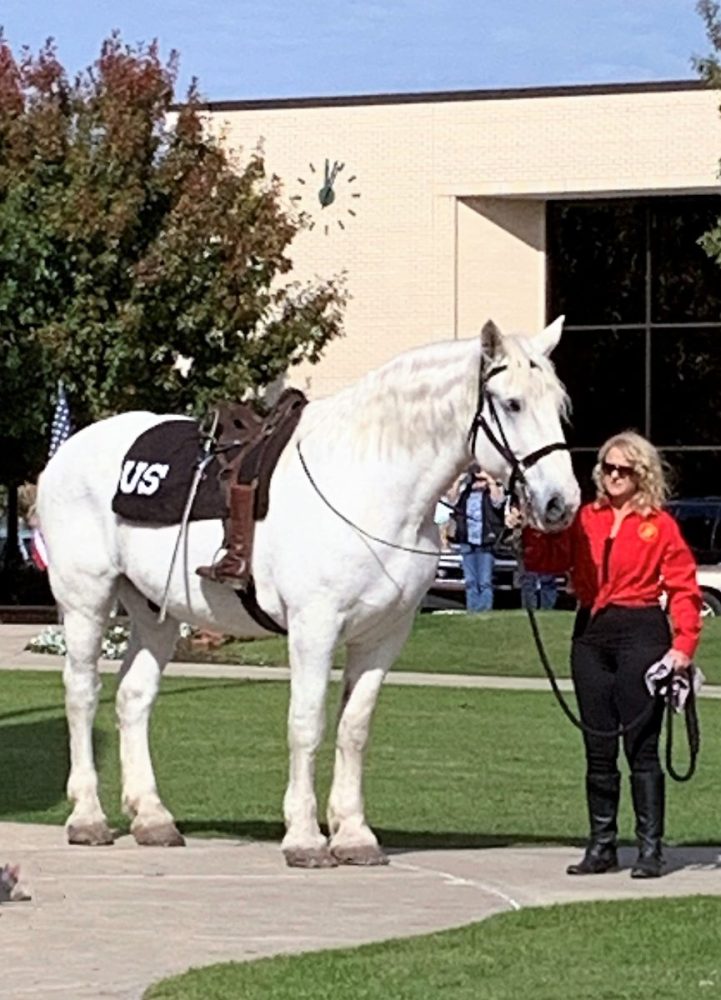
Sarge is a Percheron gelding which belongs to a Como, Texas family. Sarge is trained to carry out a duty when he is called to service during military events. He served close to home on Thursday, November 11, 2021 when he and his owner Melissa Harris were invited to represent the Riderless Horse during the downtown Veterans Day observance in Sulphur Springs, Texas. That day, Sarge and Mrs. Harris became honorary members of the Hopkins County Marine Corps League.
The riderless horse ceremony is a powerful military symbol that stands among the highest honors for the fallen. Referred to as ‘caparisoned’, the Cap Horse carries a saddle and is led by the Cap Walker with the boots of the deceased placed in the stirrups backwards. The horse’s trappings may also include a weapon and portions of uniform of the fallen. The backwards boots are intended to symbolize the rider looking back towards the living one last time before riding into the beyond. A caparison, or cloth covering laid over a horse or other animal for protection and decoration, is derived from the Latin caparo, meaning a cape.
The symbolism of the riderless horse carries much meaning in America’s early history. From a 2020 article in the Delaware Gazette’s Veterans Corner, we find that at the end of the 18th century in the United States, with the death of America’s first president, a new role emerged: the riderless horse representing the mount of a fallen leader.
A former officer in the American Revolutionary War, Henry “Light-Horse Harry” Lee eulogized George Washington in December 1799 as being “…first in war, first in peace and first in the hearts of his countrymen…” Twelve days after Washington’s death at Mt. Vernon, a riderless horse took part in an elaborate, simulated funeral ceremony conducted in Philadelphia, the then-capital of the United States, with an empty casket symbolizing the late president. Immediately preceding the clergy in the funeral procession, two Marines wearing black scarves escorted the horse, who carried the general’s “saddle, holsters, and pistols” and boots reversed in the stirrups. The riderless horse was “trimmed with black — the head festooned with elegant black and white feathers — the American eagle displayed in a rose upon the breast, and in a feather upon the head.”
The empty boots facing backward in the stirrups had two levels of meaning. First, their being empty indicated the individual would ride no more. Secondly, they suggested the deceased was taking one last look back at his family and the troops he commanded. Both of these meanings carry forward to today’s tradition of boots reversed in the stirrups.

In 1865, President Abraham Lincoln was honored by the inclusion of a riderless horse at his funeral. When Lincoln’s funeral train reached Springfield, Illinois, his driving horse, Old Bob, who was draped in a black mourning blanket, followed the procession and led mourners to Lincoln’s burial spot.
Following President Kennedy’s assassination on November 22, 1963, his wife Jacqueline drew from the funeral services for America’s first slain president, Abraham Lincoln, when planning her husband’s services. For this honor, 16-year-old Black Jack was selected for the role. The horse received the U.S. Army brand on his left shoulder and an Army serial number (2V56), before his training began at Oklahoma’s Fort Reno in 1948.

For his memorable role on November 25, he would carry a pair of polished, spurred boots placed backward in the saddle’s stirrups, and a sword or saber, during JFK’s funeral procession televised around the world. Black Jack would again serve as the caparisoned horse in the funeral for two more U.S. presidents: Herbert Hoover in 1964, and Lyndon B. Johnson in 1973. He also performed his riderless role during the funeral of General Douglas MacArthur in 1964, as well as more than 1,000 other military funerals. During late life, the equine celebrity appeared during countless field trips for school students before he was retired in 1973 and euthanized in 1976 at approximately 30 years of age. After his cremation, Black Jack’s remains were buried on the parade grounds of Ft. Myer with full military honors.





